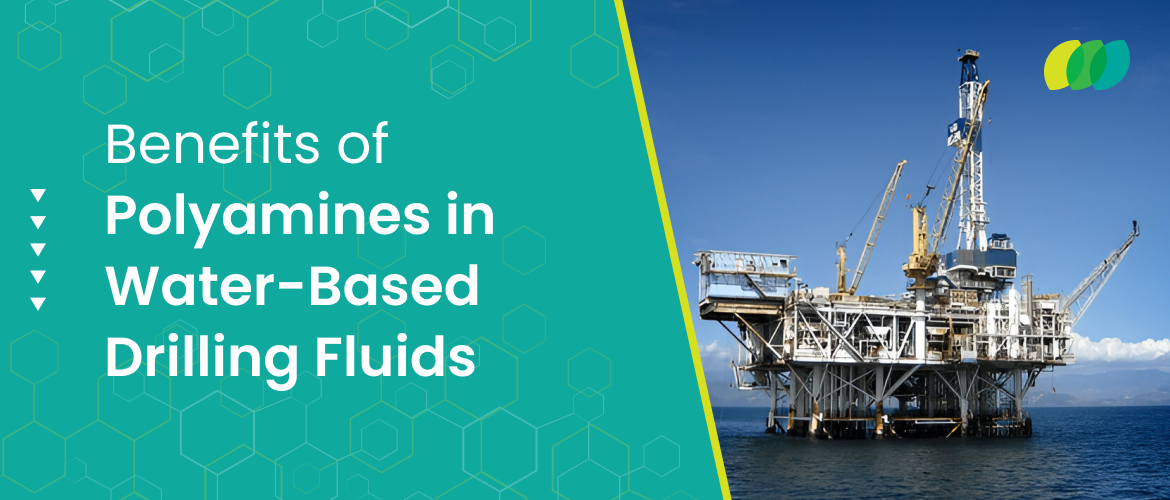If you have worked on a rig—or even reviewed a daily drilling report—youknow this: things rarely go as planned. The bit gets stuck. The mud needsadjustment. Shale starts reacting. And suddenly, your fluid system is underpressure—literally.
That is why chemical additives are not just “nice to have.” They are essential. But while many get attention, one group quietly does the heavy lifting behind the scenes: polyamines.
They are not flashy. But they make sure your fluid system behaves. And when you are running a tight operation, that makes all the difference.
What are Polyamines?
Think about this. You are drilling. Things are running smoothly. Then, out of nowhere, Shale acts up. Circulation drops. Mud gets unstable. And suddenly, your day just got longer.
Now, most people do not stop and say, “We need polyamines!” But maybe they should. Even though these compounds don’t get much spotlight, they are often the reason the operation stays on track.
In simple terms, polyamines are organic compounds. They contain multiple amine groups. But for us? What matters is what they do in the field. And what they do is keep shale from turning your operation into a mess. They limit swelling. Support wellbore integrity. And let you drill with less drama.
What Makes Them Actually Useful?
Nobody on a rig is obsessing over chemistry diagrams. What matters is results. And Polyamines deliver. Here is what makes them worth using:
- They can handle the heat. High temperatures? No breakdown.
- They play well with others. They work smoothly with most otheradditives.
- They stay calm. No unnecessary foaming.
- They are salt-friendly. Works in salty conditions without losing effectiveness.
Basically, the formation is unpredictable? Polyamines help settle things down.
The Real Benefits
Let’s break down the actual value you get:
1. Fewer Interruptions
Polyamines help reduce borehole swelling. Less swelling? Fewer stuck pipes. That means less downtime. The crew stays focused, not scrambling.
2. Lower Mud Maintenance
Stable cuttings lead to smoother mud performance. You do not have to constantly adjust the system. That means:
- Fewer chemical additions
- Less dilution
- Less waste
3. Smoother Drilling
Many operators have noticed lower torque and drag after switching to polyamine-treated fluids. It is not flashy. But it is effective. Fewer surprises. More consistent drilling. Better control.
4. More Environmentally Acceptable
Water-based systems already get points for being cleaner than oil-based muds. When you use polyamines, you get similar performance in tough formations – without the environmental baggage of OBMs.
Drilling Performance With vs Without Polyamines
| Parameter | Without Polyamines | With Polyamines |
| Borehole Stability | Frequent swelling &collapse | Improved, consistent |
| Stuck Pipe Incidents | Higher | Significantly reduced |
| Mud System Adjustments | Frequent | Minimal |
| Torque and Drag | Higher, unpredictable | Lower and more stable |
| Mud Dilution Requirements | High | Reduced |
| Environmental Impact | Moderate | Lower (within WBMlimits) |
| Additive Compatibility | May causefoaming/conflicts | Highly compatible |
Downsides
There are not many downsides yet Polyamines are not always plug-and-play. Dose matters. Too little, and it doesn’t stabilize anything. Too much? It can mess with mud rheology. It also does not fix every problem. If you are dealing with extreme clay activity, you might still need KCl, glycols, or other inhibitors.
But when used smartly? It’s a valuable tool — no question.
Looking Ahead
As oil and gas operations are pushed to go cleaner, smarter, and leaner, there is more pressure to move away from oil-based muds. But formations have not gotten any less reactive. That’s where polyamines are getting attention. Researchers and service companies are even working on tweaking polyamine blends – fine-tuning them to behave better under certain pressures or temperatures.
In a way, they are evolving with the industry.
Final Thoughts
Polyamines might not be flashy, but they are solid. They keep things steady, prevent avoidable messes, and help crews stay on schedule. Polyamines do not fix everything. But when it comes to water-based drilling fluids, they solve a lot of problems before they ever happen. And that is what smart drilling is all about.

